Earth |
Earth wanders | |  Automatic translation Automatic translation | | Updated June 01, 2013 |
The Earth is a supernatural blue point, an oasis of life in the middle of an unlimited Universe. The age of the Earth is at present esteemed at 4550 million years. The Earth is the only planet the name of which does not result either from a God Roman, or from a Greek God. It is in the nebulas that are born planetary systems. To create a planet we shall thus go to a nebula where the regions of birthrate abound, we shall use two sociable dispositions, the electromagnetic strength and the force of gravity, for the rest it will be necessary to leave from time to time...
The Earth arises from some interstellar dust.
In the heart of a nebula of gas and dusts, the heat, by means of violent collisions, is going to oblige a nucleus to arrest an electron. When the temperature comes down below the million degrees, electrons settle around the nucleus on the most close orbits. Alternately places are occupied, atoms look for themselves, appear and molecules originate to form an extremely solid network: dusts.
The matter gets organized everywhere in the universe in the same way.
Interstellar dusts are the bricks of planets, they agglutinate to constitute small racing cars, which of collision in collision form objects which grow to the detriment of their neighbors.
Their masses and their gravity increase, attracting towards them more and more small objects. The collisions free a big quantity of heat.
Atoms split and wait for the cooling to reconstitute molecules. Later, there will be joining of simple molecules then complex molecules to arrive at this magnificent molecule of DNA which from now on will know how to reproduce itself and remember of the information, so opening the way to the biological evolution.
The position of the Earth in the universe was the source of long debate setting for centuries philosophers, scholars and monk. A long time the earth was considered in the center of the universe.
In this conception, the Earth centrism asserted that everything the heavenly objects, Sun, the Moon, the planets and the stars, revolved around the Earth.
What is visually and seemingly the case, but is only a simple optical illusion.
Copernicus revolutionized this conception by showing that the Earth is on orbit around the sun, and that the moon is a natural satellite of the earth.
If heliocentrism is indeed an astronomical reality, centering the solar system in the middle of the universe is another mistake, to the regret of the human egocentrism. The solar system is only in the outskirts of our galaxy, itself located somewhere in the vast universe. | | 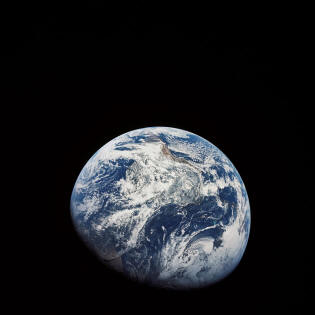 Image taken by Apollo 8. Image: The Earth slides majestically on an ideal orbit, not letting perceive no track of the formidable strength which leads it. We fall in the infinity by describing spirals ceaselessly modified and we shall never return to the place where we are today. Day and night while the sky spreads a panorama changing above our heads, our Earth, this small dust of star, turns on her even carefree of the next day. Often it shows us of magnificent images as haloes, auroras borealis...
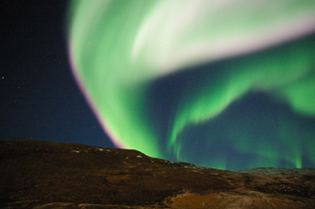 | | | Characteristics | | | | | Average orbital beam
(1 ua) | 149 597 887 km | | Circumference of the orbit | 9,4×108 km,
or 6,283 ua | | Eccentricity of the orbit | 0,016 710 22 | | Period of sidereal revolution | 365,256 96 days | | Average orbital speed | 29,783 km/s
107 218,8 km/h | | Inclination of the orbit | 0° | Diameter equatorial
(Rayon) | 12 756,28 km
(6 378,14 km) | Diameter polar
(Rayon) | 12 713,55 km
(6 356,78 km) | | Flattening in the poles | 0,0033529
1/298,242 | | Perimeter equatorial | 40 075,03 km | | surface | 510 067 420 km² | | volume | 1,083 21×1012 km³ | | Masse | 5,973 6×1024 kg | | Average density | 5515 kg/m³ | Gravity
(lat. 45°, alt. 0) | 9,806 m/s² | Gravity
(lat. 0°, alt. 0) | 9,780 m/s² | Gravity
(lat. 90°, alt. 0) | 9,832 m/s² | Period of rotation
(sidereal day) | 0,997 258 days, or
23,934 19 h | Rotation speed
(in the equator) | 1 674,38 km/h | | inclination of the axis | 23,45° | | Albedo | 0,367 | | Liberation speed | 11,186 km/s | | Temperature on the surface | min -89.2°C
mean 15°C
max 56.7°C | Atmospheric
pressure height 0 | 101 325 Pa | | azoth N2 | 78,11 % | | oxygen O2 | 20,953 % | | argon Ar | 0,934 % | | water H2O | de 0 à 7 % | | Carbon dioxide CO2 | 0,039 % ≈2006
0,028 % <1850 |
|
Spherical Earth | | | | |
Eratosthenes was one of the first ones to imagine spherical Earth.
He observed the shadow of two objects situated in two places, Syene and Alexandria, June 21st (summer solstice) at the local solar noon. It is at this precise moment of the year when in the north hemisphere the Sun holds the highest position above the horizon. Now, Eratosthenes noticed that there was no shadow in a well to Syene (city situated about on the Tropic of Cancer); so, at this precise moment, the Sun was vertical and went directly in the heart of the well.
Eratosthenes noticed however that an obelisk of Alexandria formed a shadow. | | By calculations of trigonometry, Eratosthenes deducted that the angle between sunbeams and vertical line was 7,2 degrees.
Two hypotheses were then imperative, that is:
The Earth is flat, but the Sun is rather close so that the difference of beams is significant.
The Earth is curved, and sunbeams reaching the Earth are any parallels, then it is the sphericity of the Earth that creates the difference between Alexandria and Syene. Eratosthenes calculated then the distance between Syene and Alexandria by appealing to a bematiste Un Bematiste is a land surveyor of antique Egypt which had the load to measure distances in number of steps ( bêma ). Eratosthenes used a bematiste to measure the distance between Alexandria and Syene (Assouan) to measure the circumference of the earth. which based itself at the time in the days of walking of camel enter both cities: | | the obtained distance was 5000 stadiums, that is 800 km, measure very close to the reality, a stadium (length used in the stadiums of Olympia or Delphos) being approximately worth 157,5 m.
Eratosthenes proposed a figure of brilliant one simplicity: it consisted of a simple circle having an angle in the center of 7,2 degrees which intercepts a bow (connecting Syene in Alexandria) of 800 km.
By connections in circles, he obtained that the circumference of the Earth was 39 375 km (5000*157,5*360/7,2/1000), extraordinarily precise measure for period. |
Life | | | | |
The life is a mysterious and universal tendency of the matter to join, to get organized, to complicate.
The alive is characterized by the fact that it draws some energy from the outside middle, uses this energy, throws back the waste and enriches its order, its organization.
On the scale of the sorts, the alive does not stop the complexity since 4.5 billion years.
The not alive evolves always in time in the sense of their disorganization.
It is the growth of the entropy (from Greek review) It is a function thermodynamics. Thrown in a turbine, the water of a dam transforms its gravitational energy into electrical energy. Later, we shall make a movement in an electric engine or of the heat in a radiator. Throughout these transformations, the energy degrades in other words, its entropy increases. The entropy of a system remains constant when it returns to its initial state by a reversible transformation. The total entropy of an isolated system always has to increase, its disorder always has to grow, it is the second principle of the thermodynamics. (measure of the disorder). Not alive produced of the entropy and alive produced of the negative entropy, or still the neguentropy.
The life is nothing else than a commonplace mechanism, that a particular shape of the matter, the secret of which we are certainly going to drill. | | NB: The extrasolar planets often appear to have elliptical orbits, which vary enormously temperature, which is not ideal for the emergence of life. Image: Satellite photo: notice on the enlarged photo, frail membrane of the ground atmosphere which protects the life. | | 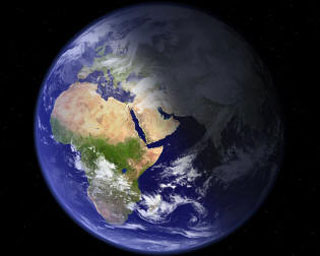 |
Earth's atmosphere | | | | |
The Earth's atmosphere is the coverage of gases surrounding the Earth. The dry air is made up of 78.08% nitrogen, 20.95% oxygen, 0.93% argon, 0.038% carbon dioxide and traces of other gases.
The atmosphere absorbs ultraviolet solar radiation, warming the surface, trapping heat by greenhouse gases and reducing the temperature difference between day and night. The atmosphere protects life on Earth as a membrane protects the cell. There is no defined boundary between the atmosphere and space, the outer boundary of the atmosphere is defined as the distance where the supposed atmospheric gas molecules constantly undergo gravity and interactions of its field magnetic. It varies greatly depending on the latitude and the magnetic field continuously deformed by the solar wind. As seen in the picture, it becomes thinner and fades gradually into space. However, the altitude of 120 km marks the boundary where atmospheric effects become noticeable during atmospheric reentry of an object. The Kármán line, at 100 km, is also considered the boundary between atmosphere and space.
The atmosphere is divided into several layers of varying importance. Their limits were set according to discontinuities in the temperature variations, depending on the altitude knowing that the temperature decreases with altitude. | | The different atmospheric layers of the Earth:
- Troposphere (change in Greek): the thickness of the troposphere varies between 0 and 13 to 16 km at the equator, and between 0 and 7 to 8 km at the poles. It contains 80 to 90% of the total mass of air and substantially all of the water vapor. This is the layer which produce weather phenomena (clouds, rain, heat convection, winds).
- Stratosphere is above the troposphere, stratospheric layer up to 50 km altitude. This is where lies much of the ozone layer.
- Mesosphere is this layer which is between 50 and 80 km altitude where the temperature decreases to -100° Celsius.
- Thermosphere is the layer which is around 80 km and goes up to 640 km altitude. In this layer the temperature increases with altitude and can reach over 1000 ° C, but the pressure is so low that it is not felt.
- Exosphere is the layer that vanishes in space up to 10 000 km altitude. For researchers at the University of Manchester, there is no doubt.
The origin of the Earth's atmosphere can only come from the degassing of the mantle as it is still written in many textbooks. Their isotopic analyzes requires another explanation, that of comets for example... | | 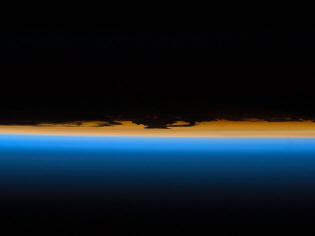 Image: This magnificent sunset, we can see the different layers of the Earth's atmosphere. This image of the horizon of the Earth, with bright colors, was taken July 29, 2009, the STS-127 crew orbiting Earth in the space shuttle Endeavour. The shuttle had just completed a trip of 16 days and 10 million km. Image Credit: NASA |
Eccentricity of the Earth | | | | |
The annual movement of revolution of the Earth, is moving the Earth to one degree per day in its orbit (360° in 365 days), with a lag of about 4 min between the mean solar day and the sidereal day. The Earth-Sun distance, which is 149.6 million km, on average, varies during the year. Earth passes each semester, alternately, at perihelion, i.e. it is at this time closer to the sun and at aphelion, i.e. it is at this moment the most away from the sun.
The difference between these two distances is determined by the eccentricity.
The orbital eccentricity is 0.017.
Eccentricity measures the deviation of the Earth's orbit with respect to a circular orbit. It goes from 0 for a circular orbit at 1 for a highly elliptical orbit. But the eccentricity of Earth's orbit varies very slightly over time, between 0 and 0.06 with a period of 100,000 years. Calculating variations in temperature due to the eccentricity between the aphelion and perihelion are 4 ° Celsius. | | 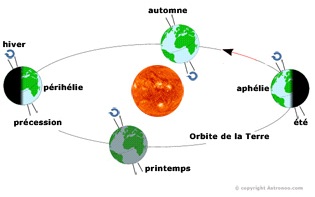 Image: calculation of the temperature change due to the eccentricity. | | 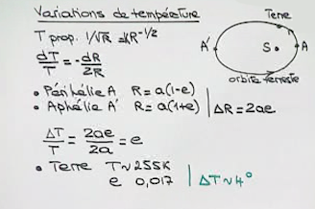
T = theoretical average temperature, A = perihelion,
A' = aphelion, ΔR = distance variation,
e = eccentricity, ΔT = 4° Celsius. |
Orientation of the axis of the Earth | | | | |
The inclination of the axis is the angle between the axis of rotation of a planet and its orbital plane.
The Earth's axis (23 ° 27 ') recovers 50.3" per year or 1 degree every 71.6 years, a full cycle (360°) lasts 25,765 years, called great platonic year.
In the solar system, the planets have orbits which are all roughly in the same plane. That of the Earth is called the ecliptic.
An exception is Pluto, whose orbit is inclined 17° 2' relative to the ecliptic but Pluto is no longer considered as a planet. Each planet rotates around its axis of rotation, which causes the succession of days local to each planet.
The slow change the direction of the axis of rotation of the Earth is called the precession of the equinoxes.
This angle (23° 27') is the succession of the seasons. Indeed, in the summer the sun is higher in the northern hemisphere than in the southern hemisphere.
The sun is high in the sky of the northern part of the globe, in the southern part. Sunlight arrive on Earth with more intensity. The sun rises earlier sets later, and the days are longer. In the southern part it is winter.
The Sun also appears lower on the horizon and the days are shorter, the sun rises later and sets earlier. At the equator the length of day and night does not change (although the Sun's position in the sky varies).
The poles, day and night lasts for six months each.
The summer solstice is the longest day in the Northern Hemisphere. The Sun is at its zenith at noon of the Tropic of Cancer, which has a latitude of 23° 27' north. | | It is the shortest day in the southern hemisphere.
The winter solstice is the shortest day in the Northern Hemisphere.
The midday sun is at the zenith of the Tropic of Capricorn, which has a latitude of 23° 27' south.
This is the longest day in the southern hemisphere. Equinoxes of spring and autumn days duration is equal to the nights, north and south, and the sun is at its zenith at noon the equator.
The Moon is moving away from Earth at a rate of about 38 mm per year, producing as a result of tides, the lengthening of Earth's day of 23 microseconds per year. Over millions of years, these small changes produce large changes.
For example there are 410 million years to the Devonian period, there were 400 days in a year terrestre, each day lasted 21.8 hours. Image: inclination of the axis of the Earth (23°27'). | | 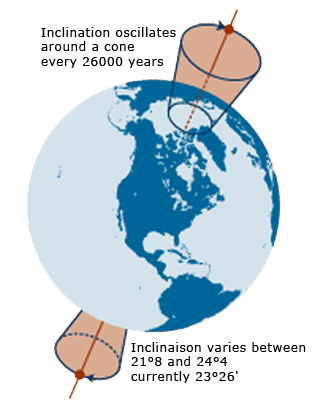 |
Passage dates at aphelion and perihelion | | | | |
Dates of passage of the Earth at its aphelion and perihelion are not regular.
For the Sun we speak of a Aphelion (from the Greek "apo" away and "helios" sun), the farthest point between the object and the Sun and a perihelion ("peri" around and "helios" sun) , the nearest point. But more generally speaking of apsis which designate the two extreme points of the orbit of a celestial object.
The point at the minimum distance from the center of the orbit is called periapsis. The point at the maximum distance from the center of the orbit is called Apoapsis. The main axis of the ellipse that connects the periapsis and apoapsis an orbit is called apsis line. The names of these points, the closest and farthest from the central object, are specific of the central object name (Greek root of the name of the celestial object). Image: Dates of passage of the Earth at its aphelion and perihelion. | |
| Year |
Perihelion |
Aphelion |
| |
|
|
| 2014 |
Jan 04 11:59 |
Jul 04 00:13 |
| 2015 |
Jan 04 06:36 |
Jul 06 19:40 |
| 2016 |
Jan 02 22:49 |
Jul 04 16:24 |
| 2017 |
Jan 04 14:18 |
Jul 03 20:11 |
| 2018 |
Jan 03 05:35 |
Jul 06 16:47 |
| 2019 |
Jan 03 05:20 |
Jul 04 22:11 |
| 2020 |
Jan 05 07:48 |
Jul 04 11:35 |
| 2021 |
Jan 02 13:51 |
Jul 05 22:27 |
| 2022 |
Jan 04 06:55 |
Jul 04 07:11 |
| 2023 |
Jan 04 16:17 |
Jul 06 20:07 |
| 2024 |
Jan 03 00:39 |
Jul 05 05:06 |
| 2025 |
Jan 04 13:28 |
Jul 03 19:55 |
| 2026 |
Jan 03 17:16 |
Jul 06 17:31 |
| 2027 |
Jan 03 02:33 |
Jul 05 05:06 |
| | 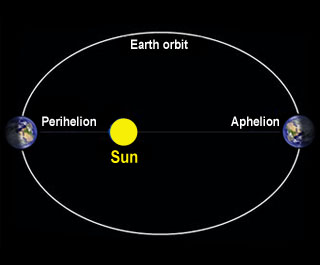 |
Structure of the Earth | | | | |
Planets are supposed to be constituted by successive layers of increasing density. Matters are in the order of their density, the iron in the center then iron sulphide, silicates, water, nitrogen, carbon dioxide, ammonia, methane, helium, hydrogen. There are nevertheless two identical planets in their structures. Each has the appropriate characteristics. The native, first iron condensat Solid grains of condensed chemical and mineralogical compounds be born in nebulas, following that we call: the sequence of condensation. The first compounds which condense in 1300°C, are oxides rich in titanium, aluminum and calcium. Towards 1050°C condenses massively the metal iron, then towards 950°C, the first silicate in this particular case the silicate of magnesium and iron. Towards 800°C, form silicates with more cowardly structures, feldspars and iron sulphide. In even lower temperatures condenses a silicate containing some water and in 0°C the water condenses icy. Plentiful, is the constituent of the ground nucleus. The silicon, the silicate of magnesium and iron constitute the essential constituents of the ground coat. The feldspar, condensat which gives the basalt constitutes the floor of the ground oceans. The internal structure of the Earth is thus distributed in several successive envelopes, the earth's crust, the coat and the nucleus. This representation is very simplified because these envelopes can be decomposed themselves. To track down these layers, the seismologists use seismic waves, as soon as the speed of a seismic wave changes brutally, it is that there is change of middle, thus layer. This method allowed, for example, to determine the state of the matter to big depths (deep coat, nucleus). These layers are bounded by the discontinuities as the discontinuity of Mohorovicic, that of Gutenberg, either that of Lehmann. Earth formed by accretion of meteorites and during this formation, the various layers organized by respecting the density of its constituents. | | The theory of the plate tectonics is widely admitted now since the end of the 60s and is widely imperative in the scientific world. In 19th century we had difficulty in believing that whole continents can derive. We know now that the solid coat is animated by immense currents of convections which circulate since millions of years. The image which we have now is that of an active and complex planet the crust of which consists of oceanic and continental patches, different mineralogical compositions, ceaselessly in movement under the action combined by currents of convection intern and of the ground gravity. Continental blocks form by collisions of continental patches and tear, according to a cycle of 400 million years. Heavier, oceanic patches, participate in this ceaseless ballet since several billion years and often eventually plunge, inside the Earth by subduction so participating in the recycling of earth's crust. Image: Structure of the Earth, crust solid in surface has a thickness of 30 to 65 km, upper mantle viscous has a thickness of 670 km, lower mantle elastic thickness of 2180 km, liquid outer core, a thickness of 2270 km and solid inner core has a thickness of 1220 km. | | 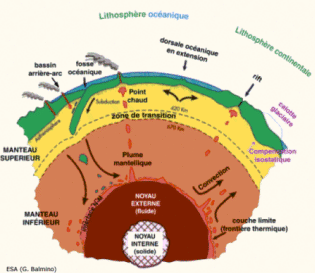 |
Gravity | | | | |
Because gravity is attractive, it tends to gather material of the universe to form objects such as clusters of galaxies, galaxies, stars and planets.
They may for a while, resist the pressure of contraction by their thermal pressure in the case of stars or by rotation or moving in the case of galaxies, but finally, once evacuated, the subject stellar starts to shrink.
The theory of general relativity Albert Einstein established in 1915, describe gravity as a curvature of space-time, meaning that all objects in the universe, bend space-time and affect other celestial bodies according to their mass.
Over the celestial object is massive, more curved space-time. The force of gravity is a manifestation of the distortion of space-time as a result of the material inside. It is not known yet how to spread the force of gravity, scientists expect the world experience confirm the existence of quantum gravity. | | In the context of general relativity, gravity is not a force or interaction since the body moving in this space-time without any force in accordance with geodetic (line in a curve). The celestial objects are actually curved space-time by gravity. The gravity is not identical in all respects of the Earth. Point g = 9832 m / s ² in Paris g = 9809 m / s ² (average value of gravity on the surface of the Earth) and the equator g = 9780 m / s². g increases with latitude because the Earth is not round but slightly flattened at the poles. g depends on the distance that separates us from the center of the Earth. Image: It is quite easy, to represent the curvature of spacetime in two dimensions, imagining the canvas of a trampoline, bent by several heavy objects, like the picture below cons. For against this is not possible in three dimensions as in reality. | | 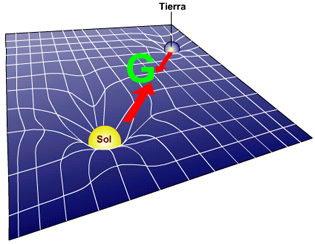 |
 Automatic translation
Automatic translation












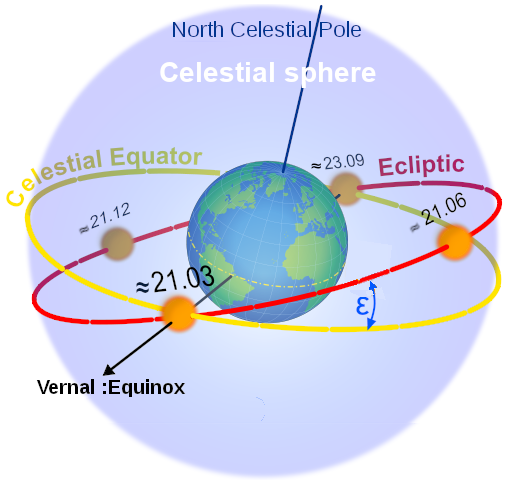 When does spring start?
When does spring start?
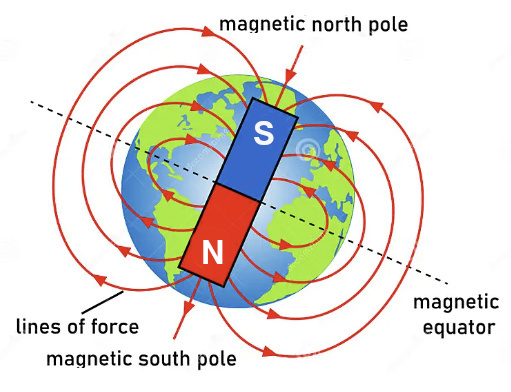 Reversal of the Earth's magnetic field over time
Reversal of the Earth's magnetic field over time
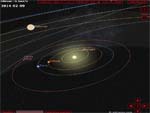 Simulator, the revolution of the planets
Simulator, the revolution of the planets
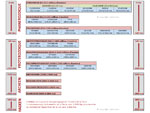 Earth's geological time
Earth's geological time
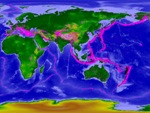 Ocean water from elsewhere
Ocean water from elsewhere
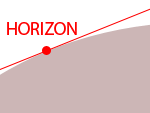 How to calculate the distance from the horizon?
How to calculate the distance from the horizon?
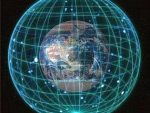 Declination and right ascension in the celestial sphere
Declination and right ascension in the celestial sphere
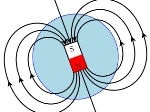 Earth's magnetic field reverses every 100,000 years
Earth's magnetic field reverses every 100,000 years
 South Atlantic Anomaly (SAA)
South Atlantic Anomaly (SAA)
 Classification of tornadoes
Classification of tornadoes
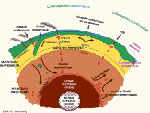 Life-giving radioactivity
Life-giving radioactivity
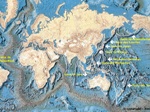 The great ocean trenches
The great ocean trenches
 Measure the passage of time
Measure the passage of time
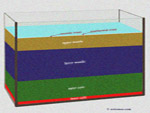 And if we put the Earth in an aquarium
And if we put the Earth in an aquarium
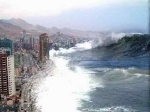 Earth in crisis, the end of a stable world
Earth in crisis, the end of a stable world
 Earth
Earth
 And she spins majestically
And she spins majestically
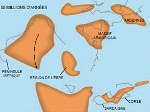 Water reservoirs on Earth
Water reservoirs on Earth
 How much is the sea level rising?
How much is the sea level rising?
 Planetary Darkening
Planetary Darkening
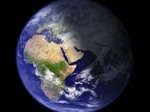 The life of the Earth perceived by man
The life of the Earth perceived by man
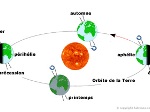 Effects of Earth's Eccentricity
Effects of Earth's Eccentricity
 The explanation of the Little Ice Age
The explanation of the Little Ice Age
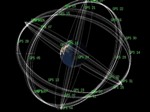 The orbital waltz of GPS satellites
The orbital waltz of GPS satellites
 Astronomy and Anxiety of the Past
Astronomy and Anxiety of the Past
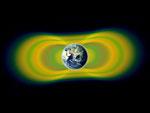 Van Allen Radiation Belt
Van Allen Radiation Belt
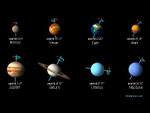 Axis of rotation of the planets or obliquity
Axis of rotation of the planets or obliquity
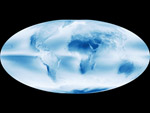 The disturbing cloud cover of the Earth
The disturbing cloud cover of the Earth
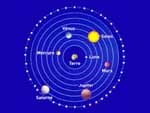 Anthropocentric and geocentric vision
Anthropocentric and geocentric vision
 The Galilean Cut
The Galilean Cut
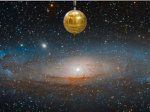 Foucault's pendulum swings relative to what
Foucault's pendulum swings relative to what
 Problem of longitude at sea
Problem of longitude at sea
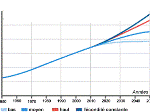 World population, still gallopingin 2008
World population, still gallopingin 2008
 Global warming
Global warming
 The oldest image of the Earth
The oldest image of the Earth
 Life evolves in the shelter of glaciations
Life evolves in the shelter of glaciations
 Impact theory at the origin of the Moon
Impact theory at the origin of the Moon
 What is an anti-twilight arch?
What is an anti-twilight arch?
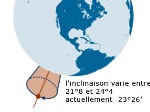 Obliquity at the origin of the seasons
Obliquity at the origin of the seasons
 Liquid water, chemical reaction accelerator
Liquid water, chemical reaction accelerator
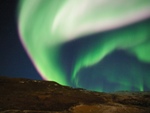 The aurora and its rays of light
The aurora and its rays of light
 The new definition of the astronomical unit
The new definition of the astronomical unit
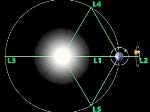 Lagrange points L1 L2 L3 L4 L5
Lagrange points L1 L2 L3 L4 L5
 Planet water, extraterrestrial element
Planet water, extraterrestrial element
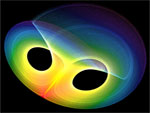 Chaos and sensitivity to initial conditions
Chaos and sensitivity to initial conditions
 Simulator, the round of near-Earth cruisers
Simulator, the round of near-Earth cruisers
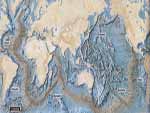 Satellites that measure underwater relief
Satellites that measure underwater relief
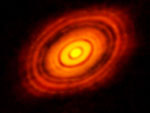 Hadean's Hell
Hadean's Hell